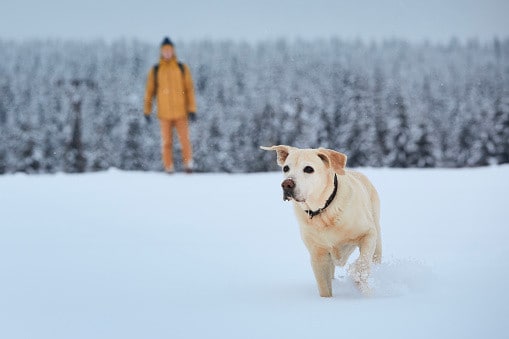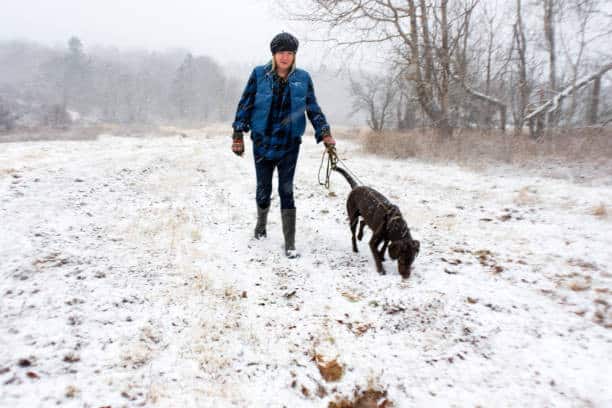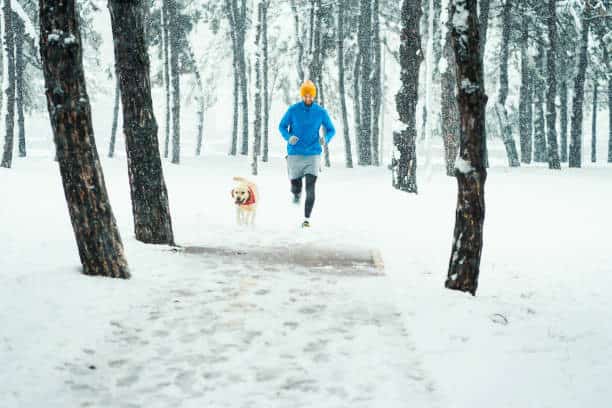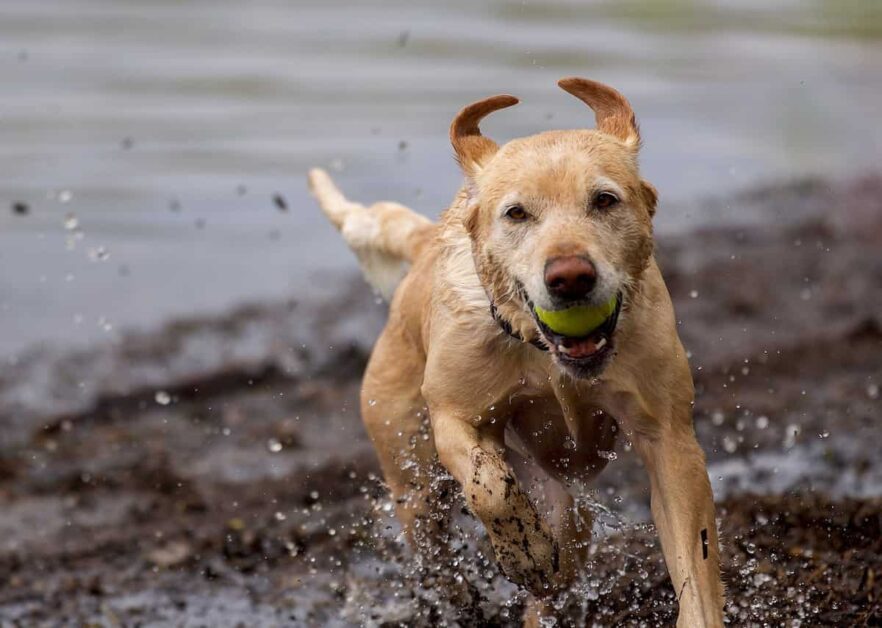The Labrador Retriever breed is hardy and like cold weather quite well. Known for their loyalty and exuberance, Labs are a popular breed among dog lovers. However, just like humans, they can get cold and uncomfortable if exposed to extremely low temperatures. So when is it too cold to walk a labrador? If the temperature drops below 20 °F (-7 °C), limiting your Lab’s time outside is wise.
You can help keep them warm by providing them with a cozy dog jacket or sweater As for walking your Lab in cold weather; it’s safe if you take precautions to keep them warm and dry.
Do Labs Like Cold Weather? Why?
Labradors have a thick double coat that helps insulate them from the cold, making them better equipped to handle colder temperatures than other dog breeds.
The Dual Coat
The Labrador Retriever’s dual coat helps them withstand cold weather. Comprised of two layers, the outer coat consists of short and dense straight hairs that are water-resistant, while the inner layer is soft and fluffy, providing insulation against the cold.
Labradors were originally bred as working dogs for hunting waterfowl in Newfoundland’s harsh climate. Their coats were designed to protect them from cold and repel water, enabling them to swim through frigid waters.
Safety
Due to their double coat, Labs can tolerate cold weather better than other dog breeds. To keep your Lab safe in cold climates, consider providing them with proper shelter—ideally insulated and protected from wind chill.
Limit the time they spend outside when temperatures fall below 20 degrees Fahrenheit.
Look out for signs your labrador needs help; shivering, whining, or lethargy. Regular veterinary checkups are also essential before winter arrives.
The Labrador’s Cold Origins
The Labrador has a fascinating history rooted in Canada. Hailing from the rocky shores of Newfoundland (hence their original name, Lesser Newfoundland dogs), Labradors initially served as hardworking partners to local fishermen navigating icy waters during the 16th century.
Labrador’s temperature tolerance can be credited to their double coat and remarkable adaptability dating back centuries.
Effects Of Cold In Labs Of Different Age Groups
As dogs age, their ability to regulate body temperature decreases. This makes senior labradors more susceptible to the effects of cold weather. They may need extra care and attention, such as warm bedding and appropriate outdoor gear.
Puppies also have less-developed mechanisms for regulating body heat and are at risk for hypothermia in extreme cold.
Is It Safe For Labs To Sleep Outside In Cold Weather?
It is generally unsafe for any dog breed to sleep outside in cold weather without proper shelter and protection.
Labradors’ thick double coats insulate them from the cold and regulate their body temperature. Wind chill, icy water, and wet fur can significantly affect a dog’s skin and cause hypothermia.
It is essential to provide adequate shelter, like an insulated kennel with plenty of bedding to keep your labrador warm.
Additionally, keep enough fresh water at all times for your lab since dehydration in the cold is just as likely as in hot weather.

Factors That Determine How Cold Is Too Cold
Several factors can determine how cold is too cold for your Labrador:
- Coat Type: Labradors have a thick double coat that protects them from the elements. But some Labs may have a thinner coat or may not have developed their full coat yet, making them more susceptible to the cold.
- Age: Puppies and older dogs are generally more vulnerable to cold temperatures because they have less body fat and weaker immune systems.
- Health: Dogs with chronic illnesses or obese Labradors may struggle more in extreme cold weather and require extra care.
- Activity Level: If your dog is active outdoors or does strenuous activities, they generate more heat to keep warm. But if they are inactive or sedentary, they may feel the cold more easily.
- Humidity and Chill: Cold temperatures combined with high humidity and wind can make it harder for dogs to maintain their body temperature and stay warm.
Signs Your Labrador Is Feeling Cold
Here are some signs that your Labrador is feeling the chill:
- Shivering: Just like humans, dogs shiver when cold.
- Clumsiness: If your usually coordinated dog seems uncoordinated and wobbly, it could be a sign of hypothermia.
- Pale gums: Your dog’s gums should be a healthy pink. It could be a sign of cold stress if they look pale or blueish-gray.
- Sluggishness: If your usually energetic dog is moving slowly or seems lethargic, it could be because they’re feeling the cold.
- Whining or whimpering: Your Labrador may vocalize their discomfort by whining or whimpering when feeling cold.
- Curling up in a ball: When dogs curl up tightly with their paws tucked under them, they protect themselves from the cold.
- Seeking warmth: If you notice your dog snuggling up to warm objects like heaters, radiators, or even other pets or humans, it’s a sign that they’re trying to warm up.
- Cold ears and feet: Like us, dogs’ extremities can get very cold in chilly weather.

When Should You Get Your Labrador Retriever Inside?
It is important to keep an eye on your Labrador when they are outside in cold weather. Look out for warning signs that indicate it’s time to bring them indoors, such as shivering, a slowed pace or lethargy, and the dog feeling overly cool.
Senior or obese Labradors may have difficulty regulating their body temperature and should be monitored closely during the colder season.
4 Tips For Keeping Your Dog Warm Outside
Provide Shelter From The Elements
Providing your Labrador with proper shelter from the cold elements is essential during winter.
- Provide a solid shelter that protects your dog from wind, rain, and snow.
- Insulate the shelter with straw or dog bedding material to create a comfortable and warm sleeping area for your pup.
- Use a waterproof cover over the shelter’s entrance to keep it dry and protect it from icy drafts.
- Raise the shelter slightly off the ground to prevent moisture from seeping in.
- If you’re using an outdoor kennel, ensure it has good insulation to help regulate temperature and protect your dog from extremely cold temperatures.

Use Insulated Kennels
When it’s cold outside, having a well-insulated kennel can be a lifesaver for your Labrador. Here are some tips on how to make the most of an insulated kennel:
1. Choose the Right Size: Make sure the kennel is big enough for your dog to move around in but not too big that they’ll have trouble staying warm.
2. Insulate the Floor: Use straw or other natural insulation material to keep your dog comfortable and dry.
3. Add Extra Bedding: Blankets or towels can help keep your dog warm and cozy.
4. Block Out Drafts: Cover any gaps in the walls or roof with plastic sheeting and flap over the doorway to keep out icy gusts.
5. Check Regularly: Monitor the temperature in your dog’s kennel regularly, especially during extreme cold snaps, to ensure they are safe and comfortable.

Winter Outdoor Gear For Dogs
Keeping your Labrador warm and comfortable during the winter is important.
1. Winter Coats: Labradors may need extra insulation to stay warm in cold. Look for a coat that fits snugly, covers the torso and neck, and is made of material that repels moisture.
2. Boots: Protecting your Labrador’s paws from cold surfaces, ice, and snow is crucial in winter weather. Boots can also prevent salt from irritating their paws.
3. Sweaters: If your Labrador tends to get cold easily or has a thin coat, consider adding a sweater or fleece layer under it for extra warmth.
4. Paw Balm: Cold air and icy surfaces can cause dryness and cracking on your dog’s paw pads. Using paw balm regularly can help prevent this discomfort.
5. Antifreeze Collars: If you live where antifreeze is commonly used, it’s vital to keep your Labrador safe from ingesting it by using an antifreeze collar.
6. Portable Heating Pads: For longer outings in the cold, portable heating pads can keep your lab warm while outside.
Provide Nutritious Food And Plenty Of Water
Labrador Retrievers require extra calories to maintain their body heat during cold weather. Make sure your dog has access to plenty of fresh water and provides them with nutritious food that will sustain their energy levels. However, never overfeed.
How to Protect Dogs That Spend Prolonged Time Outside In Cold Temperatures?
Limiting Time Outside
While Labradors can handle the cold, they should not be left outside for prolonged periods. Here are some tips for limiting your dog’s time outside during chilly weather:
Monitor their behavior: Monitor your Labrador to see how they respond to the cold. It may be time to bring them indoors if they seem uncomfortable or restless.
Shorten walks: While exercise is important for your dog, try shortening their daily walks during colder weather to limit their exposure to the elements.
Increase indoor playtime: Bring out the toys and games inside so your Labrador can still get exercise and mental stimulation even if they can’t spend as much time outdoors.
Adjust feeding schedules: Consider feeding your dog earlier in the day so they have plenty of time to digest before going outside in the cold.
Provide plenty of water: Ensure your dog can access fresh, unfrozen water, especially if they spend extended periods outdoors.

Be Aware Of Frostbite
Frostbite is a real concern for dogs during the cold weather, especially areas of low circulation such as their ear tips, tail, and paw pads. Signs of frostbite in Labradors include discoloration (grayish-yellow or bluish-white), swelling, pain, and even blackening of affected body parts.
If you notice any signs of frostbite in your Labrador after being outside in cold conditions for an extended period, seek veterinary care immediately. To prevent frostbite, limit your dog’s time outdoors when it’s extremely cold and provide them with booties to protect their paws from icy water or sharp ice crystals.
Do Labradors Like Winter?
Labradors tend to love winter and cold weather. This is because they were originally bred for cold climates, such as the Canadian coastal town of Labrador, where they got their name. Their coat insulates them well. That being said, each dog is different and may have varying tolerance levels.
Do Labradors Need Jackets In Winter?
Labradors generally do not need jackets during winter. However, precaution is wise. Arranging for a jacket for freezing temperatures is recommended.
The jacket you purchase must fit well and not restrict your Labrador’s movement or breathing. Their ears, feet, and tail must stay uncovered as these areas help regulate their body temperature.
How Do I Know If My Labrador Is Cold At Night?
One of the easiest ways to know if your dog is cold at night is by touching their ears or paws. If they are too cold, these areas will feel colder than usual.
Another way is by taking its temperature. The normal body temperature for dogs ranges between 101-102 degrees Fahrenheit. Anything below this range could mean your dog has caught a chill and needs extra warmth.
Age is crucial in determining how well Labradors can tolerate low temperatures. Young puppies and older dogs are more vulnerable to extreme weather conditions. Obese Labs or those with chronic illnesses also need extra care as they may not cope well in the colder months.

FAQ
What temperature is too cold for a Labrador to be outside?
Labrador Retrievers can handle cold temperatures, but generally, any temperature below 20°F (-6°C) is too cold to be outside for an extended period.
How long can a Lab be out in the snow?
The amount of time a Lab can be out in the snow depends on the temperature, but it’s best to limit their time outside to 20-30 minutes to prevent hypothermia and frostbite.
What is the temperature range for a Labrador retriever?
The temperature range for a Labrador Retriever is generally between 50°F to 85°F (10°C to 29°C). They can handle temperatures outside this range, but extreme temperatures should be avoided.
Do dogs get cold at night?
Dogs can get cold at night, especially if they sleep outside or in a drafty area. Providing a warm, comfortable bed and blankets can help keep them cozy.
Do labs need a coat in winter?
Labs have a double coat that provides insulation, so they usually don’t need a coat in winter. However, if the temperature drops below 20°F (-6°C), a coat can provide extra protection.
Do Labradors like blankets?
Many Labs enjoy blankets, especially during colder months. A soft, warm blanket can make them feel more comfortable and secure.
How do I keep my Labrador warm in the winter?
To keep your Lab warm in the winter, provide them with a warm, dry place to sleep, a coat if needed, and plenty of blankets. You can also feed them more calories to help keep their body warm.
Is 60 degrees too cold for a Labrador?
60 degrees Fahrenheit (15.5°C) is not too cold for a Labrador, but they may need a coat if they are outside for long.
What ideal temperature is comfortable for a Labrador?
A temperature between 50°F to 85°F (10°C to 29°C) is comfortable for a Labrador.
How long can dogs be outside in 50-degree weather?
Dogs can be outside in 50-degree weather, but it’s important to provide them with a warm, dry shelter and to monitor their behavior for signs of discomfort.
Can Labradors sleep outside in winter?
Labs can sleep outside in winter. Provide them with plenty of insulation, such as blankets or straws.
How cold is too cold for Labrador?
Any temperature below 20°F (-6°C) is too cold for a Labrador to be outside.
What is the highest temperature for a Labrador?
The highest temperature a Labrador can handle is around 85°F (29°C). Any temperature above this can cause heat exhaustion or heat stroke.
How long can a Lab stay outside in 10-degree weather?
A Lab can stay outside in 10-degree weather for a short while. But exposure to this temperature for long may be harmful to them
Do Labradors need winter boots?
Labs do not necessarily need winter boots, but if they walk on ice or snow, they can provide extra protection and prevent injury.
Author Profile
- Site Owner And Planning Specialist
-
Aritra, the founder of Labradorandyou.com, is a lifelong dog lover whose passion ignited for Labradors for their loyalty and intelligence. With extensive research and personal experiences, Aritra has become a Labrador expert, offering a rich resource on the breed. Labradorandyou.com provides reliable, timely, and evidence-based information, including Labrador-specific product reviews, training techniques, and care tips.
Labradorandyou.com was born out of Aritra's passion and his desire to share his profound knowledge about the breed. The site serves as a comprehensive resource, offering a wealth of up-to-date information for Labrador owners and enthusiasts alike
Also by the author
-
 FAQNovember 17, 2023How To Adopt An Emotional Support Dog?
FAQNovember 17, 2023How To Adopt An Emotional Support Dog?
-
 Mix-BreedsNovember 16, 2023Red Labradoodle Ultimate Guide: Breed Facts, Care Tips
Mix-BreedsNovember 16, 2023Red Labradoodle Ultimate Guide: Breed Facts, Care Tips
-
 Top BreedersNovember 8, 2023Breeding Labradors: Everything You Need to Know
Top BreedersNovember 8, 2023Breeding Labradors: Everything You Need to Know
-
 FAQOctober 17, 2023Do Dogs Like Music? Researchers Say Yes! Find Out
FAQOctober 17, 2023Do Dogs Like Music? Researchers Say Yes! Find Out





